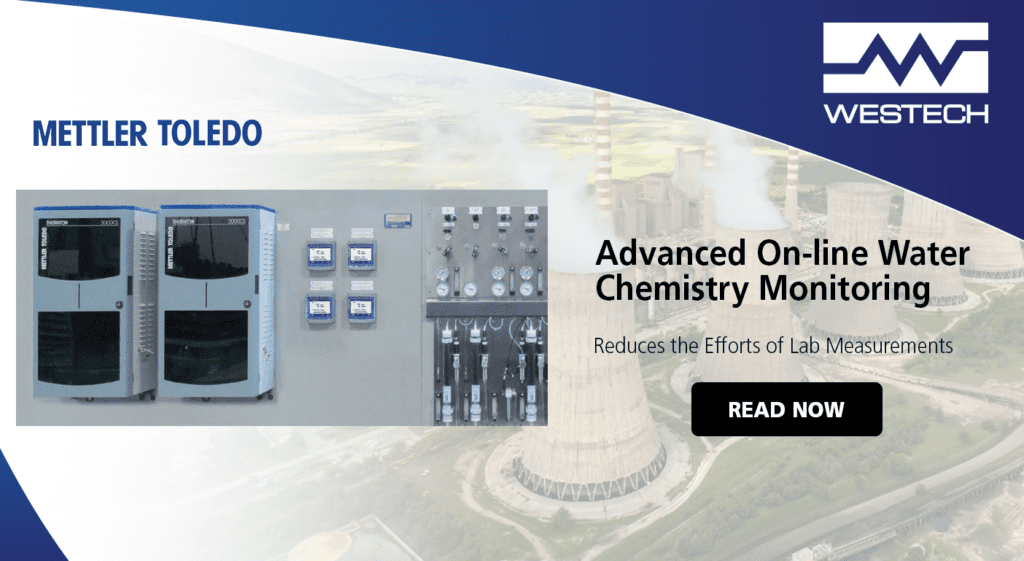Advanced On-line Water Chemistry Monitoring – Reduces the Efforts of Lab Measurements

Today's power plants face many difficult challenges, including maintaining and managing water / steam chemistry measurements within safe parameters. Long-term efficient power generation requires careful surveillance to guard against corrosive and depositing conditions and to ensure conformance with industry guidelines. On-line analytics from METTLER TOLEDO provide accurate and reliable measurements that power plant operators can trust to improve measurement accuracy, response time to critical problems and to reduce corrosion and contamination.
Especially as cycling plants become more common, power plants face increased stress to boilers and turbines, staffing and expertise losses, and growing pressure to reduce costs.
Discrepancies Between On-line & Lab Measurements
In the past, it was possible to maintain a combination of on-line and lab measurements for validation, control and response to urgent water/steam upsets. In some cases, as on-line analytics aged or were not properly maintained and calibrated, the measurements from these instruments became unreliable. Plant operators did not trust the on-line data and began to depend on daily lab measurements in order to maintain control.
This scenario led to redundancy between untrusted on-line measurements and infrequently performed lab measurements, often with confusingly different results. Plants still in this position have a high-risk of misunderstood water chemistry and, ultimately, damaged plant assets. Advanced On-line Water Chemistry Monitoring Reduces the Efforts of Lab Measurements Especially as cycling plants become more common, power plants face increased stress to boilers and turbines, staffing and expertise losses, and growing pressure to reduce costs.
Digital Technology in On-line Sensors Provide Reliable Results
Advancements in on-line analytics provide low maintenance sensors and analyzers that feature the advantages of digital technology and significantly reduce risks, expenses and time requirements while improving reliability.
In combination with a multi-parameter M800 transmitter, METTLER TOLEDO digital sensors equipped with Intelligent Sensor Management (ISM®) ensure that measurements are accurate and reliable. Correct sensor calibration data is always utilized because it is stored in on-board memory and therefore goes with the sensor to the installation point. In addition, ISM sensors feature real-time predictive diagnostics that provide advance warning of when service will be needed, before sensor failure or loss of accuracy occurs.

These sensors fully exploit the opportunities available when measurements are made right next to the sensor element. They do not compromise the measuring circuit design in order to accommodate the resistance and capacitance of long analog signal cables. They also eliminate uncertainty when different measuring circuits are used to calibrate the sensor than are used in the final installation, because the measuring circuit is inseparable from the sensor elements.
The multi-channel, multi-parameter M800 transmitter for use with METTLER TOLEDO high accuracy conductivity sensors, have the ability to perform calculated pH and CO2 measurements. Using these calculated measurements along with dedicated sensors for each parameter provides the user with the most accurate method for their application, as well as confirmation that sensor measurements are reliable. The M800 transmitter accepts inputs from any combination of four analytical sensors and can derive multiple measurements from each one, providing great convenience and flexibility.
Advances in Measurement Technology Allow New On-line Measurements
Many power plants continue to rely on lab measurements because they are not aware of the latest technologies that have entered the market. Advancements allow for the elimination of measurements that formerly required laboratory testing. Measurements can be moved on-line with easy integration into existing steam and water analysis system (SWAS) panels.
For example, it is now possible to measure low ppb levels of two of the most corrosive contaminants in power plants, chloride and sulfate, with the METTLER TOLEDO on-line 3000CS analyzer. Existing methods to monitor the levels of these contaminants are either a substitute measurement such as cation conductivity, or have a high cost of acquisition and operation. Using microfluidic capillary electrophoresis (MCE) technology, the 3000CS analyzer provides a specific and continuous method of monitoring chloride and sulfate contamination that is easy to use and maintain.
In addition, there is an increasing awareness of the operational risks and damage that organics can cause in power generation equipment. With the METTLER TOLEDO 4000TOCe and 6000TOCi sensors, plants are now experiencing the advantages of continuously monitoring for organic contamination entering and damaging the boiler. Using proven UV oxidation technology, these sensors provide constant and reliable TOC monitoring and can be easily integrated into the same transmitter and sensor set as conductivity, pH and dissolved oxygen.
Predictive Diagnostics Ensure Accurate Measurements
ISM provides highly accurate measurements that power plants can rely on. Digital sensors with ISM predictive diagnostics tools help planning for routine maintenance and avoidance of last minute calibration and repairs. The Dynamic Lifetime Indicator (DLI) provides real-time sensors status, Time To Maintenance (TTM) advises when maintenance is required or something should be replaced and the Adaptive Calibration Timer (ACT) predicts when calibration should be performed. With such predictive diagnostics, power plants can change their maintenance strategy from reactive and costly to planned and controlled.

On-line Measurements Reduce Costs & Provide Faster Responses
METTLER TOLEDO Thornton’s on-line analytics provide accurate and reliable measurements that power plant operators can trust, while utilizing innovative new technology that reduces risk and increases efficiency. Thanks to advanced on-line measurement instrumentation, power plants can realize a number of significant advantages over lab based techniques:
- Accuracy: Testing water quality directly in the water cycle results in a more accurate measurement, uncompromised by poorly cleaned grab sample vials/ containers, airborne cross contaminants, temperature differences and human error.
- Lower costs: Typically, on-line analytical systems are significantly less expensive to purchase, calibrate, service and maintain than their laboratory counterparts. In addition, laboratory testing equipment and the methods required to perform the tests require special training/knowledge that can be easily lost due to infrequent testing intervals and/or personnel changes.
- Reduced labor: Collecting grab samples from different sample water streams can be time and labor intensive while introducing possible human errors that will negatively affect results. These errors can then trigger additional sample collection, leading to frustration, further lost time and added labor.
- Faster response: The continuous measurement of water quality allows for faster response and correction of water chemistry problems before expensive damage can occur to critical power plant components.

Learn More
Check out our product range of Mettler Toledo Advanced On-line Water Chemistry Monitoring by visiting our product page or call to speak to one of our technical representatives at 1-800-912-9262.
